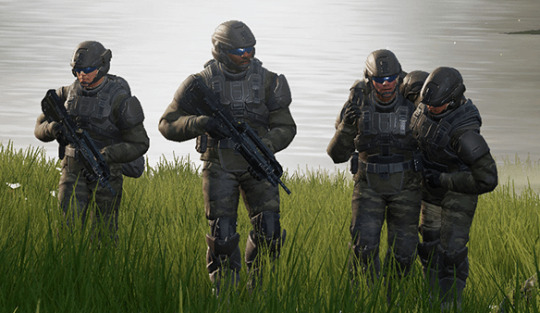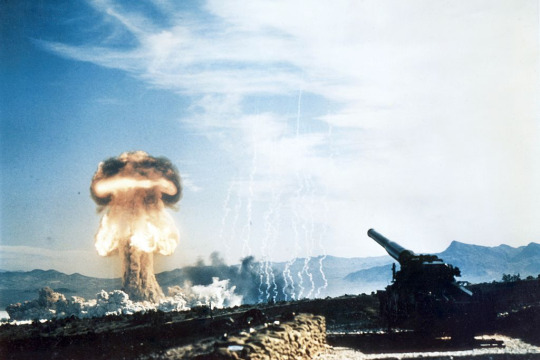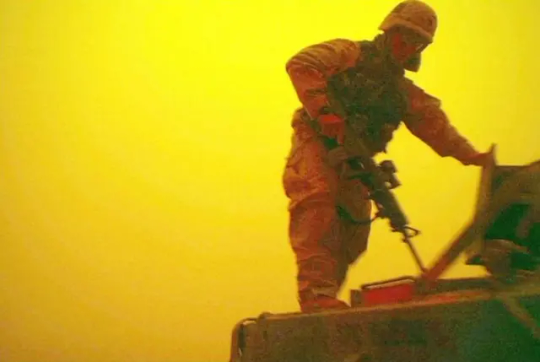Text




Halo CE - Novermber 15th, 2001
4 notes
·
View notes
Text




Formed in 1973, the French GIGN (or Groupe d'intervention de la Gendarmerie nationale) is the specialized anti-terrorism force for the French Gendarmerie. They were originally formed to combat hostage situations, but their scope has expanded since then. They were most notably used in 1994, during the Air France hostage raid. They're most well known for their navy blue uniforms, and their favored use of the Manurhin MR 73 revolver, although this is no longer used in the field.
9 notes
·
View notes
Text




Entering JSDF service in 2012, the Type 10 MBT is the current, fourth-gen, MBT used by the Japanese military. Following a trend in many NATO-aligned Asian countries, the Type 10 is built around it's command and control, while also boasting good AT protection. While sharing a lot of lineage with the Type 90, the Type 10 features improved C4I ability, the commander is given a larger field of view, and while lighter than the Type 90, is better protected. The weight of the Type 10 is an important sticking point, as the previous Type 90 was too heavy for many of Japan's bridges, which prevented its mobility around the island. However, the Type 10 is light enough to regain most of this mobility.
1 note
·
View note
Text




Adopted in 1994, the Swedish CV90 (Combat Vehicle 90) is the current Swedish IFV. Fitted with a large 40mm autocannon, the CV90 specializes in the snow covered, freezing wetlands of the Nordic countries. Carrying 6-8 dismounts, the CV90 has also seen export to a number of countries, largely the other Nordic states.
2 notes
·
View notes
Text




From 20 - 24 of November, 1943, the US Army conducted an amphibious assault on the Makin Atoll within the Gilbert Islands. The Japanese had taken the island as a means of cutting off US Naval vessels in the Pacific, and act as a safeguard to the Marshall Islands. After a thorough bombing campaign, the Island would be captured over the course of the next few days. This battle would serve as an important proving ground the the US "island hopping" strategy in the Pacific.
13 notes
·
View notes
Text




Beginning life in 1993 as a joint German-French venture, with the UK joining shortly thereafter, the Boxer AFV has a storied history. The French would drop out of the program just six years after it began to pursue what would become the VBIC, and just 2 years after that, the Netherlands would join the project. The first prototype of the Boxer would be unveiled in 2002, but the UK would signal its intention to withdraw in 2003. They would later rejoin in 2018. With such a long development history and the number of prototypes submitted, there are a large number of variants in service all around the world. The current and future list of users is a long one, including Australia, Germany, the UK, Netherlands, and Lithuania, just to name a few.
2 notes
·
View notes
Text




Entering service in 1983, the LAV-25 was based on a license built version of the Swiss Piranha amphibious IFV. In the early 1980's, the US Marine Corps was looking for a new light armored vehicle for added divisional mobility and aiding in reconnaissance. The Army was initially interested in adopting the LAV as well, but backed out after its funding was pulled. The would however, borrow several from the Marine Corps during the Gulf War. The LAV has seen action everywhere from Panama to Afghanistan, but the Marine Corps isn't looking to replace it anytime soon, planning to keep them in service for roughly another decade.
2 notes
·
View notes
Text




Entering service in February of 1944, the T-34-85 was the first large modification to the T-34 tank, adding an 85mm gun designed to counter the German Tiger, and an improved, widened, three-man turret. The design would further be developed and perfected over time, but the original T-34-85 variants would always be the most crucial. The widening of the Turret helped with on of the T-34 main issues, how cramped it was. The T-34 was incredibly tightly packed on the interior, with very little room to work. While not entirely solving this issue, the larger three man turret certainly reduced the strain on tank crews. The larger gun however, was the main selling point of the 34-85. Able to penetrate the frontal armor of a Tiger I at 1,000 metres. It would be the tank that pierced the heart of Berlin, and would lead the invasion of South Korea by the North Koreans, beginning the Korean War.
#military#military history#soviet military#soviet army#soviet union#ww2#wwii#eastern front#T-34#T-34-85
95 notes
·
View notes
Text




Although only entering service in July 2014, the K2 Panther MBT started its life in 1995, with a South Korean shift in military ideology. The South Korean military shifted towards a "three-dimensional" warfare strategy, and needed a new MBT with a heavy focus on command and control, rather than mobility, firepower, or armor. The result was an auto-loading, 56 ton MBT with a 120mm main gun and a 3-man crew. The K2 Panther has also been exported to both Turkey and Poland.
1 note
·
View note
Text




A member of the Stryker family of IFVs that were adopted in the early 2000s, the Stryker MGS (or M1128 Mobile Gun System if we're being fancy) was another Stryker variant, this time mounting a 105mm gun, was produced and used in very limited numbers, while the US Army played politics over whether to adopt the system or not. While it would finally enter service in limited numbers in 2008, it would be replaced just 5 years later by the Griffin tank in the MPF program. The Stryker MGS would be retired in 2021 - 2022, with the introduction of the M10 Booker. The Stryker MGS was expensive to service, inadequately protected, and arguably not air-mobile enough. But as a beautiful, mobile, light gun system, the idea would survive, and eventually birth the MPF program.
1 note
·
View note
Text




The BTR family of vehicles are certainly an oddity. Adopted in 1959, the BTR-60 was the true start of the BTR line of amphibious APCs. Seating 14-16 cozy dismounts and 2 crew, the BTR-60 was made to replace the older BTR-152 and BTR-40 vehicles in Soviet service, which were found disappointing largely because of their lack of a roof. With the accompanying decision to restructure many units to the Motor Rifle Division layout, a new, armored APC was needed. Development would lead to two vehicles, the BTR-60, a lighter, cheaper, APC concept designed primarily for offloading infantry in Motor Rifle Divisions, and the more expensive BMP-1, which, while called an APC, was really more of an IFV concept for use in Tank Divisions. The BTR-70 would be an incremental improvement on the 60, while the BTR-80 would be considered a larger modernization effort. The BTR-90 would come into existence in the early 90's, but has mostly only been present on paper.
#military#military history#russia#russian armor#russian military#russian army#soviet union#soviet army#soviet#btr#BTR-60#BTR-70#BTR-80
11 notes
·
View notes
Text




Adopted by the Soviets in 1966, the BMP-1 was designed as the APC that would carry Soviet troops through the nuclear battlefield. Although considered an APC by the Soviets, it functions more like a modern IFV from a doctrinal standpoint. With its radiation shielded interior to protect infantry in the event of a nuclear war, the BMP-1 would be able to move through irradiated areas, and then dismount Soviet infantry when in a safer location, and provide fire support all the while. The BMP-2 would of course supercede it, making general improvements across the board. The BMP-3 would feature a larger redesign, especially in regards to its main gun. The BMP family has found a new life on the battlefields of Ukraine, where it has become a cozy underwater casket for Russian infantry.
1 note
·
View note
Text




Launched on the 16 April, 1944, the USS Pueblo was a Banner-class environmental research ship that would later become the star of one of the most controversial incidents of the Cold War. In 1967, the US Navy converted the mothballed cargo ship into a "spy ship" equipped with surveillance equipment, and later armed. Sent on patrol off the North Korean coast, the Pueblo would be harassed by a North Korean submarine, 2 North Korean fishing boats, and finally a submarine chaser. This submarine chaser would challenge the Pueblo, the Pueblo attempted to retreat, but was chased down by the craft, which was later joined by four torpedo boats, another submarine chaser, and two MiG-21s. After hours of evasion, the North Korean vessels would open fire on the Pueblo, who's crew began destroying sensitive documents. There are a couple oddities I'll bring up here. There is much dispute as to whether or not the Pueblo was actually in North Korean waters at the time of the incident, with North Korea obviously insisting she was, while the US vehemently opposes this idea. Secondly, the Pueblo was promised air cover after this incident began to unfold, but it never arrived. There were no aircraft ready to sortie, and it would be hours before any were in the air. The Pueblo would eventually be forced to stop, and escorted towards North Korea. She would be boarded and the crew taken hostage. The USS Pueblo would be taken into North Korean port, where she would remain to this day. She was reportedly converted into a museum ship. She is the only active commission US Navy vessel currently held hostage by another country. This was an incredibly tense moment within the Cold War. (Also I'm from Pueblo, so hometown bias.)
3 notes
·
View notes
Text




Adopted in 2002, the Stryker family of IFVs were the backbone for the US Army's medium-weight BCTs. With the stated goal of being able to deploy a capable brigade-sized force anywhere in the world within 96 hours, the Stryker was designed to be highly air-landable. Designed to function with the C-130 aircraft to deliver combat ready, loaded mechanized infantry and (possibly) heavy gun support anywhere in the world in a few days maximum. The Stryker family was a large one, consisting of many variants that covered everything from command vehicles to mortar platforms. The odd but well loved Stryker is and always will be the medium weight option for us, ever since it (and it's many, many variants) stole our hearts in 2002.
1 note
·
View note
Text




Between 1957 - 1963, the US Army experimented with the "Pentomic" structure for its infantry and airborne units. It was designed around the atomic warfare that was expected during the Cold War. Built around the concept of high-readiness and quick reaction speed. By building a balanced unit capable of most tasks, the need for inter-unit communication and reorganizing prior to an offensive would largely disappear. This was based on the fear that a massing formation prior to an offensive would become a priority target for Soviet nuclear attacks. By limiting the amount of time needed to prepare for an attack, you decrease the risk of said attacking force being wiped out.
4 notes
·
View notes
Text




In the late 1970's, the French Military was looking into a replacement for their aging AML platform of light armored cars. This would result in the 1980 adoption of the Panhard ERC. The French Military has a strong affection for the light armored reconnaissance role within their military, especially when paired alongside tanks. It would include two main variants, the older Lynx variant, and the newer, more AT focused Sagaie model.
5 notes
·
View notes



